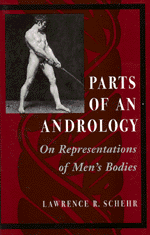

![]()
![]()

In his introduction On Plemystography, the author assures us that 'this book is not about penises' (p. 3) but rather his argument is that the penis as an organ of pleasure has been subsumed by the representation of the penis as phallus - both an instrument and a symbol of 'phallocratic power' (p. 24). He does not fully explain what he means by phallocratic power, aside from some references to previous work on the advent of capitalism and the consolidation of gendered divisions of labour (pp. 5 - 7). This undermines the sociological value of his work but it is a minor criticism; Schehr's study is clearly located within the traditions of sociological/feminist and literary scholarship which is critical of a heterosexually ordered society. He develops a complex argument which links modernist, rationalist techniques of accounting and categorisation to the classification of sexual perversions/fantasies (the technique which he calls plemystography). He suggests that since this quantification is based on the system of integers - whole numbers - the representation of the masculine as whole, integral, and clearly (bodily) demarcated is necessary to the phallocratic order in which the white male is the universal subject. Schehr then focuses on the novel Io e Lui, by Alberto Moravia, which is about the relationship (and conversations) between a man and his penis. He illustrates how this text represents the masculine body as unintegral, and, crucially, how the penis is shown as a organ of pleasure rather than an instrument of phallocratic power.
Schehr goes on to critique other texts which illuminate the white male body as vulnerable, fragile and pleasurable. In Chapter One - titled with the symbol for 'pi' (the irrational number between 3 and 4) - he focuses on Edgar Allan Poe's tale The Pit and the Pendulum which depicts a man undergoing torture, unable to see and sense his whole body in the darkness of the pit. In Chapter Two - Designing Men - Schehr's focus is on texts which describe the masculine body as pleasurable and desirable, but he argues that the problematic representation of masturbation in the texts in Chapter Three - The Writer's Hand - illuminates the absence of a continuous discourse of male pleasure in the Nineteenth Century. It is in the final chapter - From Liberation to AIDS - in which Schehr discusses in greatest detail the potential for a coherent and continuous discourse of male pleasure, represented within the writings of gay men such as Foucault during the latter Twentieth Century.
Schehr is unable to draw together all the threads of the nonphallocentric representations of the white male which he unpicks from the texts under study. This lack of a clear cut consolidation is compounded by the switch to specifically gay male writing in the final chapter, although it is clear that Schehr is arguing that gay visibility and actions have, in large part, made possible the potential reclamation of the 'penis as pleasure' for all masculinities. In his sensitive discussion of the problems and potentialities of gay sex in the era of AIDS he does point towards a model of the masculine body which is not a symbol for 'phallocratic power' and it is this final section which will provide the reader with a discussion which broadens out from literary theory to encompass socio-political events and their impact on gay identities.
Momin Rahman
University of Strathclyde